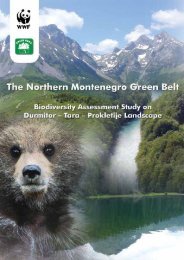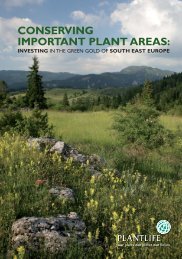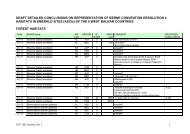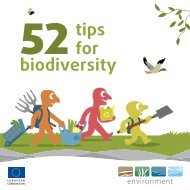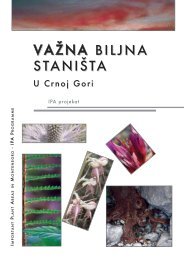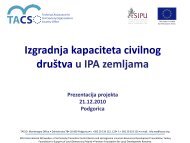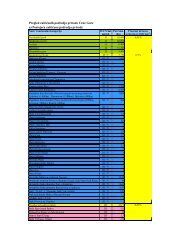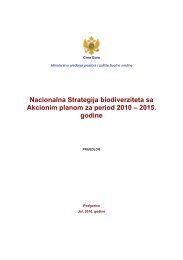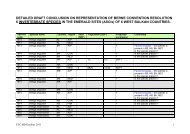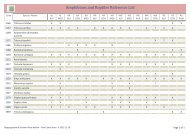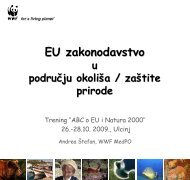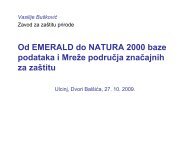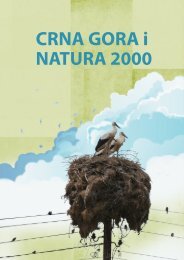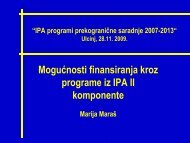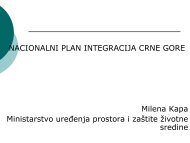prezentacije sa treninga
prezentacije sa treninga
prezentacije sa treninga
Create successful ePaper yourself
Turn your PDF publications into a flip-book with our unique Google optimized e-Paper software.
Kampanja u borbi protiv<br />
klimatskih promjena<br />
Iskustva NVO Green Home<br />
Nata<strong>sa</strong> Kovacevic<br />
NGO Green Home, December 2010.
Earth Hour –<br />
Sat za nasu planetu<br />
Globalna kampanja u borbi protiv klimatskih promjena<br />
prvi put organizovana 2007. u Sidneju (Australija) <strong>sa</strong> ucescem preko 2<br />
miliona ljudi<br />
znacajna nacionalna obiljezja zemalja (most Golden Gate u San<br />
Francisku, Kalifornija, Koloseum u Rimu, Italija, Opera kuca u Sidneju<br />
Australija…)<br />
2009 – 100 M ucesnika, 1.7. M podrzavaoca, 4088 gradova, 88 zemalja<br />
Cilj akcije podrska planeti u susret Samitu UN u Kopenhagenu u<br />
decembru 2009.<br />
NGO Green Home, September 2009.
Ciljna grupa:<br />
• Opstine (donosioci odluka)<br />
• Ministarstva<br />
• Gradjani<br />
• Privatne kompanije<br />
Aktivnosti/vremenski rokovi:<br />
• Januar:<br />
•<br />
Organizovanje<br />
kampanje 2009<br />
Postavljanje website informacija (Green Home <strong>sa</strong>jt i Earth Hour<br />
Facebook)<br />
Sastanci i dogovor <strong>sa</strong> Ministarstvima i institucijama<br />
Komunikacija i dogovor <strong>sa</strong> privatnim kompanijama i drugim<br />
insitutcijama<br />
Februar:<br />
Raspodjela informacija prije dogadjaja<br />
Dogadjaj u noci 28 Marta 2009<br />
Izvjestaj<br />
NGO Green Home, December 2010
Organizovanje<br />
kampanje 2009<br />
Ocekivani rezultati:<br />
• Ucesce najmanje 10 privatnih kompanija<br />
• Ugasena svijetla na odabranim lokacijama<br />
• Ucesce preko 20 volontera<br />
• Ucesce oko 15 nevledinih organizacija<br />
• Preko 1 000 posjetioca <strong>sa</strong>jta (Earth Hour i Green Home)<br />
• Informi<strong>sa</strong>no oko 20 000 gradjana o dogadjaju<br />
Rizici:<br />
• Lokacija okupljanja moze biti promjenjena zavisno od<br />
dopusta Opsine Podgorica<br />
• Kompanije mogu odustati od dogovorenih aktivnosti<br />
• Vremenski uslovi mogu ugroziti aktivnosti napolju 28<br />
(crtanje zvijezda)<br />
• Nezainteresovanost gradjana za dogadjaj<br />
• Izbori 29 Marta!!!<br />
NGO Green Home, December 2010
Aktivnosti<br />
kampanje<br />
•<br />
•<br />
•<br />
Sastanci:<br />
Opstina Podgorica: osoba za kontakt i<br />
komunikaciju<br />
Slavne licnosti (glumci, pjevaci, voditelji)<br />
Privatne kompanije – ProMonte<br />
Opstina Niksic: sopstveni Facebook i<br />
ucesce<br />
TV kuce: besplatno objavljivanje spotova<br />
Stampanje promomaterijala<br />
posteri<br />
Lifleti<br />
Majice<br />
solarne lampe<br />
Sirenje informacija<br />
Redovno azuriranje Facebook i GH site,<br />
uvezivanje <strong>sa</strong> globalnim dogadjajima<br />
Mail liste, bilten (mediji i NVO)<br />
Press konferencija<br />
Promocija u skolama:<br />
2 skole<br />
Predstavljanje EH<br />
Konkurs za literalni rad EH
Aktivnosti kampanje<br />
2009<br />
Prvi put organizovan u Crnoj Gori<br />
otežani uslovi: izbori, promjena lokacije, utakmica CG<br />
–IT<br />
Dogadjaju prisustvovalo 20 volontera i blizu 100<br />
građana.<br />
Grupa Krug dala podršku kampanji<br />
OŠ „Pavle Rovinski“:<br />
• Recitacija Sat za planetu zemlju posvećena Earth<br />
Hour.<br />
• ritmicki nastup učenica<br />
Predsjednik skupštine Glavnog grada dr. Đorđe<br />
Suhih<br />
Odbrojavanje do gasenja svjetala i performans EH <strong>sa</strong><br />
solarnim lampama<br />
knjiga poruka, promotivni materijal EH (majice,<br />
lifleti, solarne lampe) i <strong>sa</strong>vjeti za uštedu energije.<br />
muzika DJ Chevallije
troskovi:<br />
Utroseno vrijeme – 20<br />
radnih dana, ukljucujuci<br />
dosta komunikacije<br />
(telefonski pozivi,<br />
<strong>sa</strong>stanci,mediski nastupi,<br />
ukljucena 3-4 covjeka iz<br />
GH tima i jedan iz<br />
Opstine Podgorica).<br />
Doprinos Green Home,<br />
pokrivanjem<br />
kancelariskih troskova<br />
Materijall – EH posteri,<br />
lifleti, majice, GH brosure<br />
o ustedi energije i<br />
klimatskim promjenama<br />
EH knjiga poruka <strong>sa</strong><br />
potpisima gradjana<br />
1066 eura!<br />
Troskovi i doprinosi<br />
Doprinos stakeholders:<br />
Opstina: osoba za snimanje, proslijedjivanje materijala Tv<br />
stanicama (TV MBC, RTVCG1, RTVCG2, Montena TV)<br />
Lokalna osoba zaduzena za rad <strong>sa</strong> GH (Danilo Kalezic, PR<br />
manager of Podgorica Municipality).<br />
Prisustvo predsjednika skupstine glavnog grada na dogadjaju,<br />
pozdravna rijec, simbolicno gase svjetala i odbrojavanje.<br />
KIC BUdo Tomovic, bina i ozvucenje, postavljenje<br />
Rok bend “Krug” i DJ Chevallie, muzicki nastup<br />
Recitacija posvecena EH i ritmiski nastup 6 ucenica OS “Pavle<br />
Rovinski”,<br />
JP Komunalno, kran za snimanje gasenja svijetala iz vazduha<br />
GH volonteri prisustvo na dogadjaju, dijeljenje materijala, lampi,<br />
majica, izvodjenje performan<strong>sa</strong><br />
Nas EH FB grupa 235 clanova, 7 zahtjeva za volonterizmom
Defin<strong>sa</strong>nje akcionog plana za<br />
dogadjaj u Podgorici i Niksicu<br />
Defini<strong>sa</strong>nje partnera i<br />
zainteresovanih strana(osnovne<br />
skole, NVO, Glavnim grad, Trzni<br />
centar Delta Siti)<br />
Uspostavljanje partnerstva <strong>sa</strong><br />
lokalnim NVO i zainteresovanim<br />
stranama<br />
Izrada promo materijala (Majice,<br />
reklame u novinama, solarne<br />
lampe)<br />
Podjela informacija (website,<br />
facebook, e-lists)<br />
Organizovanje prezentacija u<br />
skolama o energetskoj efikasnosti u<br />
Niksicu (NVO Ozon)<br />
Raspodjela promotivnog materijala<br />
Aktivnosti 2010
Aktivnosti 2010<br />
Earth Hour dogadjaj<br />
27.marta<br />
Trzni centar Delta siti<br />
100 ucesnika (NVO, javne<br />
institucije, gradjani,<br />
privatna udruzenja,<br />
volonteri GH)<br />
Ucenici osnovnih skola <strong>sa</strong><br />
ucescem u zabavnom dijelu<br />
programa<br />
Performans <strong>sa</strong> solarnim<br />
lampama
Dogadjaj podrzan od<br />
strane velikih<br />
kompanija (T-Mobile<br />
i Telenor) –<br />
ugasena<br />
svjetla 60 minuta u<br />
centralnim zgradama<br />
Visoka medijska<br />
zastupljenost (5<br />
najava dogadjaja i<br />
razgovora o temi i<br />
prisustvo 6 medija na<br />
<strong>sa</strong>mom dogadjaju)
Naucene lekcije<br />
Sa malim sredstvima je moguce<br />
postici velike rezultate<br />
Rezultate kampanje je moguce<br />
koristiti i nakon njenog zavrsetka<br />
Mediji su zainteresovani za<br />
dogadjaje <strong>sa</strong> performansima (npr.<br />
Solarne lampe)<br />
Postize se bolja <strong>sa</strong>radnja <strong>sa</strong><br />
privatnim sektorom, u velikom<br />
broju slucajeva po prvi put<br />
Najzahvalniji je rad s djecom<br />
Treba razmisljati o jasnim<br />
porukama koje zelimo uputiti i<br />
efektima koje zelimo postici<br />
(dugorocno i kratkorocno)
Thanks for<br />
attention!
N2000 & BIODIVERSITY PROTECTION –<br />
COMMUNICATING WITH DIFFERENT<br />
STAKEHOLDERS<br />
MONTENEGRO, 01-03 December 2010<br />
With the support of:
Training Agenda<br />
01.12 02.12 03.12h 9.00h ‐ Opening and introduction<br />
‐ Introduction<br />
‐ Introduction<br />
Facilitation: Project team<br />
Session 4: Biodiversity protection and N2000 ‐ Session 8: Group/individual work‐ preparation of local<br />
how to talk to different stakeholders<br />
action project outline<br />
Lecture: Petra Boic Petrac, WWF<br />
MedPO,Communications Officer<br />
Facilitation: Project team<br />
10.30h Break Break Break<br />
11.00h Session 1: Developing and delivering policy<br />
mes<strong>sa</strong>ges<br />
Lecture: Christoph Stein; WWF MedPO<br />
Session 5:Practical session with local journalists<br />
and/or other media<br />
Facilitation : Petra Boic Petrac, WWF<br />
MedPO,Communications Officer<br />
12.45h Lunch Lunch Lunch<br />
14.00h Session 2: Earth Hour<br />
Lecture: Petra Boic Petrac, WWF<br />
MedPO,Communications Officer<br />
Session 6: Advocacy strategy and communication<br />
Lecture: Christoph Stein; WWF MedPO<br />
15.30h Break Break Break<br />
16.00h<br />
to<br />
17.00h<br />
Session 3: Building coalitions<br />
Lecture: Christoph Stein; WWF MedPO<br />
Session 7: Local actions on the ground –<br />
introduction to small grants<br />
Lecture: Project team<br />
Session 9:Presentation of action outline and peers<br />
review<br />
Facilitation: Christoph Stein; WWF MedPO<br />
Session 10: Evaluation & planning of next steps<br />
Facilitation: Project team<br />
Departure
LEARNING OBJECTIVES<br />
1. Learn about key aspects of successful communicating with<br />
diverse stakeholder groups about N 2000 and biodiversity<br />
protection<br />
2. Define and work out a first outline of a successful<br />
communication action in your community<br />
3. Meet representatives of local media to understand their<br />
expectations and way of working
Opening and Introduction<br />
1. Presentation of participants: Why are you here? What do<br />
you expect from the training for you and for your<br />
organi<strong>sa</strong>tion?<br />
2. Discussion of programme and way of working together
Introduction: What is advocacy?<br />
Working group exercise 1: constructing a definition of<br />
advocacy
Introduction: What is advocacy?<br />
Advocacy refers to organized efforts by citizens to<br />
influence the formulation and implementation of public<br />
policies and programs by persuading and pressuring state<br />
authorities, international financial institutions, and other<br />
powerful actors. (cedpa)<br />
Advocacy is an action directed at changing the policies,<br />
positions or programs of any type of institutions. (Ritu R.<br />
Sharma)
Introduction: What is advocacy?<br />
Advocacy is a tool for citizen participation<br />
It is one of the ways—together with elections, open forums,<br />
special commissions, and so on—that different sectors of<br />
civil society can put forward their agendas and have an<br />
impact on public policies.
Introduction: What is advocacy?<br />
Citizen participation requires:<br />
• Internal democracy<br />
• Human and economic resources<br />
• Consciousness<br />
• Willingness to struggle<br />
• Credibility<br />
• Ability to mobilize people<br />
• Good leaders<br />
• Alliances
Introduction: What is advocacy?<br />
Advocacy as the exercise of power<br />
• To the extent that the citizenry is able to influence<br />
decisions made by entities of the state, it is exercising its<br />
own power as civil society. Advocacy can be seen as the<br />
exercise of power by the citizenry in the face of the<br />
government’s power.
Introduction: What is advocacy?<br />
Why Engage in Advocacy?<br />
There are many reasons to engage in advocacy. The most<br />
important from a civil society perspective are:<br />
(a) to solve specific problems through concrete changes in<br />
public policies and programs;<br />
(b) to strengthen and empower civil society;<br />
(c) to promote and consolidate democracy.
Introduction: What is Advocacy?<br />
Conceptual framework for Advocacy:<br />
It is a dynamic process involving a changing set of actors,<br />
ideas, agendas and politics
Dimensions of Change in Advocacy<br />
STRUCTURAL<br />
CHANGES<br />
• Democratization of<br />
decision-making spaces<br />
• Ways of governing<br />
• Capacity for execution<br />
CULTURAL<br />
CHANGES<br />
• Values<br />
• Behaviors<br />
• Customs<br />
• Empowerment processes<br />
POLITICAL<br />
CHANGES<br />
• Public policies<br />
• Creation and reform of<br />
laws<br />
• Budgets<br />
• Programs
Introduction: What is Advocacy?<br />
Factors within NGOs that increase capacity to do advocacy:<br />
• Internal democracy<br />
• Willingness to interact with the government<br />
• Willingness to build and consolidate alliances<br />
• Long term vision for societal transformation<br />
• A clear mission statement.
Introduction: What is Advocacy?<br />
Advocacy step by step:<br />
1.Identify and analyse the problem<br />
2.Formulate the propo<strong>sa</strong>l: What do we want to achieve?<br />
3.Analyze the decision-making space: how and when, by whom a<br />
decision will be taken in response to our request?<br />
4.Analyze channels of influence: Who are the actors that can influence<br />
the decision-making process?<br />
5.Analyse the strength + weakness of your advocacy team/group: what<br />
are opportunities /threats to the initiative?<br />
6.Design advocacy strategy<br />
7.Develop activity plan:what must be done to carry out the chosen<br />
strategy<br />
8.Carry out continues evaluation: what has been done?
Policy Issue:<br />
Introduction- Identifying Policy Issues<br />
A problem or situation which an institution or organization<br />
could take action to solve
Introduction: Identifying Policy Issues<br />
The policy process is about selecting one policy option from<br />
among several choices, is essentially a negotiation among<br />
various actors.<br />
In order to be included in the negotiation process, data and<br />
research must be translated into information and presented<br />
in formats that policy makers can understand and use.
Introduction: Identifying Policy Issues<br />
The advocacy team has to decide what problem it wishes to<br />
solve. The policy issue should:<br />
1.Relate to the mission of the group<br />
2.Be solvable through changes in public policy<br />
3.Deeply felt by a significant section of the<br />
community/society<br />
4.Motivating for the team/group
Introduction: Identifying Policy Issues<br />
Once the problem to be solved has been identified starts a<br />
deeper analysis of causes and consequences:<br />
1.Why did the problem arise? What are the main causes?<br />
What are its consequences?<br />
2.Prioritization of the causes: which of the causes should be<br />
addressed first? Is there a cause blocking the resolution of<br />
the others?<br />
3.Detailed examination of the prioritized cause: seperating<br />
in different contributing factors
Criteria for<br />
prioritization of a<br />
problem<br />
Deeply felt by a<br />
significant<br />
section of<br />
society<br />
Politically and<br />
technically<br />
feasible to<br />
solve<br />
Motivating for<br />
the group
Introduction: Identifying Policy Issues<br />
Lessons learned from advocacy experiences:<br />
1.Inadequate information is a common obstacle that impedes the analysis<br />
of problems.<br />
2. Confusion between causes and consequences is a constant danger<br />
3. Incomplete examination of a problem can lead a group to concentrate<br />
its efforts on resolving less-important issues<br />
4.In practice, many groups prioritize problems that are of little importance<br />
to the general population. This limits the possibility for mobilizing other<br />
groups in society to act and make it difficult to maintain momentum<br />
5. Another frequent mistake is to analyze a problem without consulting<br />
those groups in society that are most affected by it.
Step 1 –Resource 7<br />
Do not confuse<br />
causes and<br />
consequences<br />
Problems that are<br />
deeply felt tend to<br />
generate special power<br />
Obtain the information<br />
needed to formulate<br />
strategies<br />
LESSONS<br />
LEARNED<br />
Move beyond<br />
generalities<br />
Analyze specific<br />
aspects of the<br />
problem<br />
Get advices from<br />
others to pinpoint<br />
the problem<br />
Involve those who<br />
are affected by the<br />
problem
Training Agenda<br />
01.12 02.12 03.12h 9.00h ‐ Opening and introduction<br />
‐ Introduction<br />
‐ Introduction<br />
Facilitation: Project team<br />
Session 4: Biodiversity protection and N2000 ‐ Session 8: Group/individual work‐ preparation of local<br />
how to talk to different stakeholders<br />
action project outline<br />
Lecture: Petra Boic Petrac, WWF<br />
MedPO,Communications Officer<br />
Facilitation: Project team<br />
10.30h Break Break Break<br />
11.00h Session 1: Developing and delivering policy<br />
mes<strong>sa</strong>ges<br />
Lecture: Christoph Stein; WWF MedPO<br />
Session 5:Practical session with local journalists<br />
and/or other media<br />
Facilitation : Petra Boic Petrac, WWF<br />
MedPO,Communications Officer<br />
12.45h Lunch Lunch Lunch<br />
14.00h Session 2: Earth Hour<br />
Lecture: Petra Boic Petrac, WWF<br />
MedPO,Communications Officer<br />
Session 6: Advocacy strategy and communication<br />
Lecture: Christoph Stein; WWF MedPO<br />
15.30h Break Break Break<br />
16.00h<br />
to<br />
17.00h<br />
Session 3: Building coalitions<br />
Lecture: Christoph Stein; WWF MedPO<br />
Session 7: Local actions on the ground –<br />
introduction to small grants<br />
Lecture: Project team<br />
Session 9:Presentation of action outline and peers<br />
review<br />
Facilitation: Christoph Stein; WWF MedPO<br />
Session 10: Evaluation & planning of next steps<br />
Facilitation: Project team<br />
Departure
Earth Hour<br />
NATURA 2000 & BIODIVERSITY PROTECTION –<br />
Global public campaigning<br />
With support of:<br />
COMMUNICATING WITH DIFFERENT<br />
STAKEHOLDERS<br />
Montenegro, 01-03 December 2010
On the last Saturday of<br />
March annually,<br />
households and<br />
businesses should turn<br />
off all<br />
What is Earth Hour<br />
lights for one hour<br />
to raise awareness<br />
towards the need to take<br />
action on climate<br />
change<br />
•1 person/ whole<br />
•Celebrations<br />
on the<br />
family/ business<br />
sector<br />
streets/ concerts<br />
•Debates on TV/ radio/ print/ web on<br />
climate change<br />
•Special<br />
way<br />
of advertising<br />
•Earth Hour symbolizes what we can do<br />
when the world acts together
Background on Earth Hour<br />
- Earth Hour began in one city, in Australia in 2007. More<br />
than 2.2 million households and businesses in Sydney<br />
- One year later, Earth Hour reached 370 cities and towns<br />
in more than 35 countries across 18 time zones - an<br />
estimated 50 to 100 million people around the world<br />
switched off their lights for Earth Hour in 2008<br />
-In its third year Earth Hour 2009 created history as the<br />
greatest voluntary action ever witnessed - 88 countries,<br />
4159 cities, more than 80 million people<br />
- In 2010 more than half billion people in more than 4500<br />
cities and towns in 128 countries turned off their lights for<br />
Earth Hour.
What you get from Earth Hour<br />
<br />
<br />
Visibility<br />
New contacts<br />
in public<br />
and business<br />
sector<br />
Your campaign - Earth Hour is the platform to push local<br />
mes<strong>sa</strong>ges for environmental communications<br />
Opportunity<br />
to be<br />
part of global movement
Issues to be communicated<br />
The biggest threat to life on earth is climate change<br />
A way in which global warming can be slowed down is if<br />
individuals make small changes to the way they live<br />
To make a change we have to show how easy it can be<br />
for individuals
Detailed<br />
Best ways to communicate EH:<br />
communications<br />
Define target groups<br />
Objectives<br />
Think of activities<br />
Available funds<br />
Expected results<br />
Define possible risks<br />
strategy:<br />
You get campaign ready to use –<br />
it depends on you how<br />
it will look like
In 2008 the<br />
Success story - Portugal<br />
Portuguese<br />
were<br />
unaware<br />
of Earth<br />
Hour<br />
In 2009 first Earth Hour – 5 months of preparations; more<br />
than 500,000 persons switched off lights in their houses; 11<br />
cities involved leaded by Lisbon; 20 companies committed<br />
with EH mes<strong>sa</strong>ge; The social networks were a good means<br />
of spreading the EH mes<strong>sa</strong>ge; 4 media partners<br />
In 2010 second Earth Hour – 3 months of preparations;<br />
more than 1,000.000 people involved; 27 cities involved<br />
with the help of ANMP (biggest success in Porto – 54<br />
monuments were in dark); 2 major sponsors (IKEA, Coca-<br />
Cola) and many partners and supports; VIPs
Based on the 1st results of 2009 when the event was organized for<br />
the 1st time:<br />
-<br />
Overall objectives for EH 2010 in Western<br />
Balkans<br />
Increase number of participating cities<br />
- Increase public participation<br />
- Increase media presence<br />
- Get between 3 and 5 private companies on board<br />
- Organize an action that will last for the whole year, to give<br />
continuity and enable to maintain and develop our profile.<br />
- Get at least 2 celebrities supporting our actions.
Overall results in 2010 in the Western Balkans<br />
• Over 60 cities and towns participating (more than doubled from 2009)<br />
• Private companies, local NGOs involved<br />
• Over 300 media outputs<br />
• Huge visibility thanks to social media and web<br />
• Around 30 actions in the 4 countries on March 27, including open air<br />
concerts (Banjaluka, Sarajevo), competition in schools with traditional<br />
games to show how playing can be fun without playstation/electricity,<br />
children exhibitions, sending children’s mes<strong>sa</strong>ges to the government,<br />
gatherings with candles in front of emblematic monuments, poetry<br />
evenings, "bookcafés" and public debates, inauguration of the first solar<br />
kinder garden in Montenegro, etc. 30 000 leaflets were distributed in<br />
Croatia through local NGOs.<br />
Two objectives were not reached (actions running all year long and<br />
celebrities’ involvement)
Results per country<br />
Bosnia & Herzegovina
Strong media presence was established thanks to adapted advertising<br />
contents (TV spots, Print ads, Internet banners...).<br />
In addition free media space was obtained in all top media and on the<br />
main billboards in each participating city.<br />
Constant communication was maintained with relevant media, including<br />
interviews, guest appearances and feature stories,<br />
press releases, etc.
A special website was created<br />
in local language, giving in<br />
particular some tips on how to<br />
<strong>sa</strong>ve energy tips.<br />
The Facebook profile for Earth hour<br />
in BiH had 4,894 followers daily<br />
during the campaign and<br />
discussions continue to this day.<br />
A twitter Earth hour profile was also<br />
developped which now has 257<br />
followers.
In kind support was obtained from Hypo Alpe-Adria-Bank,<br />
second largest banking corporation in the country.<br />
•<br />
•<br />
They placed EH 2010<br />
welcome screen ATM<br />
machines, effectively<br />
reaching thou<strong>sa</strong>nds of<br />
people every day.<br />
On March 27 they emailed<br />
a reminder to all clients.
In kind support was also obtained from Mercator supermarket in Banjaluka city<br />
•<br />
•<br />
Mercator<br />
supermarket chain<br />
supported the<br />
event with<br />
promotional<br />
banners<br />
Leaflets were also<br />
handed out to<br />
customers by<br />
promoters dressed<br />
in EH shirts
On the night: Sarajevo
On the night: Banjaluka
On the night: Livno
Results per country<br />
Croatia
Among the successful actions:<br />
- involvement of many local NGOs, covering the whole<br />
territory<br />
- media work<br />
- visits to schools<br />
- the best response was in towns Biograd and Makarska (which<br />
was joined by the neighbouring municipalities along the sea coast<br />
– all in all, more than 27,000 inhabitants), where the complete<br />
street lights were switched off.<br />
- the <strong>sa</strong>me happened in Višnjan (whose mayor, interested in<br />
<strong>sa</strong>vings on the power bill, asked why not extend the action for a<br />
whole night or more)
And more …<br />
- The city of Šibenik joined in spontaneously, by turning lights off at their famous<br />
cathedral of St. Jacob.<br />
- In Zagreb, the lights were switched off in the Tkalčićeva street, The Regent<br />
Esplanade hotel also turned off the lights on the outside of the building.<br />
- In some places the organi<strong>sa</strong>tions managed to have landmark buildings in the dark<br />
despite the non-cooperation of the city authorities (the Zadar bridge was dark from<br />
20:30 to 21:30).<br />
- In Osijek the city authorities agreed to turn off lights on the pedestrian bridge over<br />
the Drava river.<br />
- In Varaždin the lights went off on some of the main streets in the town.<br />
More than 12 cities participated
Media partners
On the night: Makarska
EARTH HOUR 2011<br />
video
EARTH HOUR 2011<br />
THE EARTH HOUR BRAND<br />
GROWS BEYOND THE<br />
HOUR TO<br />
EARTH HOUR +<br />
It’s not going to be only 1<br />
hour – let’s make it all year
EARTH HOUR 2011 – Global Key Mes<strong>sa</strong>ges<br />
1. Make an Earth Hour pledge for ongoing sustainable<br />
action<br />
2. Switch off your lights for one hour at 8.30pm,<br />
Saturday 26 March 2011<br />
3. Join the global pursuit for a better, healthier world<br />
4. Earth Hour symbolises the power of the individual,<br />
businesses and communities working together<br />
5. Everyone has responsibility, everyone has power,<br />
everyone can lead
EARTH HOUR 2011 - campaign<br />
print<br />
apps<br />
corporate<br />
tv
Thank you!<br />
Petra Boic<br />
Petrac<br />
WWF Mediterranean Programme
EARTH HOUR<br />
2010<br />
Serbia
2009 results in Serbia<br />
Local authorities in about 30 cities in Serbia has supported the<br />
action and switched off the lights<br />
4 national TV stations (B92, TV FOX, RTS, Studio B) and many<br />
local ones has invited people to participate<br />
Group on Facebook has reached 22 000 members
USP<br />
SER: Budite deo sveta u borbi protiv globalnog<br />
zagrevanja, iskljucite svetla na <strong>sa</strong>t vremena<br />
ENG: Be a part of the world battle against global<br />
warming, turning of the lights for one hour
Target Audience<br />
<br />
<br />
<br />
Individuals and households: Our aim is to reach over 1<br />
million people in Serbia. Most broadly the general public<br />
especially in Belgrade and Novi Sad<br />
National and local governments: official support and if<br />
possible active involvement of government offices (e.g.<br />
Ministry of Environment) as well as city governments,<br />
particularly those of Belgrade and possibly Novi Sad – lights<br />
off on prominent historical landmarks like the Belgrade castle<br />
(addressed through direct contacts);<br />
Private companies and other organi<strong>sa</strong>tions: at least 50<br />
companies officially signed up to actively support and promote<br />
Earth Hour (addressed through direct contacts, via chambers<br />
of commerce and other trade associations as well as through<br />
targeted media work);
Communication goals<br />
<br />
<br />
To promote public awareness of climate change and<br />
opportunities for reducing greenhouse gas emissions<br />
Increased awareness of the need for individuals to reduce CO2<br />
emissions<br />
Short term<br />
To engage as much people as possible to switch of the power for<br />
an hour during the defined period<br />
Long term<br />
To engage people to reduce power u<strong>sa</strong>ge in everyday life in order<br />
to <strong>sa</strong>ve the planet
IDEA<br />
2010 BRAND AMBASSADOR<br />
NIKOLA TESLA<br />
(10 July 1856 – 7 January 1943) was an Serbian inventor and a mechanical<br />
and electrical engineer. He was one of the most important contributors to the<br />
birth of commercial electricity, and is best known for his many revolutionary<br />
developments in the field of electromagnetism in the late 19th and early 20th<br />
centuries. Tesla's patents and theoretical work formed the basis of modern<br />
alternating current (AC) electric power systems, including the polyphase<br />
system of electrical distribution and the AC motor, with which he helped usher<br />
in the Second Industrial Revolution.
Support<br />
We provided official support from:<br />
Ministry of Environmental and spatial planning, Republic of Serbia<br />
Secretariat for Environmental Protection , Belgrade<br />
Cabinet of the Deputy Prime Minister for European Integration<br />
Mayor of Novi Sad
The results<br />
<br />
<br />
<br />
<br />
<br />
Local authorities in over 40 cities & settlements in Serbia has<br />
supported the action and switched off the lights<br />
All national TV stations in Serbia and many local ones has invited<br />
people to participate<br />
Over 90 announcements in printed & online media<br />
Various local radio stations supported the project<br />
Active online activities (including Facebook group with over 20 000<br />
members with daily updates about the project)
PRINT ADS<br />
Magazines and daily<br />
newspapers that published print<br />
ad free of charge
•<br />
BILLBOARD<br />
Regular Billboard without lights on frequent location in town free of charge
NEWSLETTER
T-SHIRTS
•<br />
PRESS CONFERENCE<br />
Press Conference speakers<br />
Goran Trivan - City of Belgrade, Secretariat for Enviromental Protection<br />
Alek<strong>sa</strong>ndar Maruncic - Academician, a professor of Electrical Engineering in<br />
Belgrade. He studied the life and work of Nikola Tesla. He was the director of the<br />
Museum of Nikola Tesla from 1982. until 1996. year.<br />
Duska Dimovic – WWF DCP<br />
Milica Stefanovic – Communication Manager, Coca Cola, Serbia
•<br />
•<br />
•<br />
•<br />
•<br />
Folder<br />
CD in CD cover<br />
PRESS CONFERENCE PROMO<br />
MATERIAL<br />
Press Release on recycled paper<br />
Stickers<br />
Flayers
EARTH HOUR EVENT<br />
<br />
<br />
<br />
III PHASE -<br />
event<br />
Few hours before EH parade of<br />
“Eco musketeers", pupils from<br />
primary schools in Belgrade, and all<br />
supporters of Earth Hour gathered in<br />
front of big monument of Nikola<br />
Tesla .<br />
As a support to the project Nikola<br />
Tesla monument was dresses in<br />
oversized EH T-shirt<br />
That was starting point of our<br />
journey through the city.
III PHASE -<br />
EARTH HOUR EVENT<br />
<br />
<br />
<br />
<br />
<br />
event<br />
From the monument of Nikola Tesla parade headed to Nikola Tesla museum.<br />
They carried big EH box full of children's mes<strong>sa</strong>ges for better planet<br />
During the walk children distributed flayers and stickers to people on the streets.<br />
In museum we were welcomed by PR of museum who told a short story about<br />
Tesla, showed us a movies and Tesla’s experiments.<br />
As a evidence of choosing perfect brand ambas<strong>sa</strong>dor for this project Museum<br />
asked for Nikola Tesla cut out to stay in museum and become part of Tesla’s<br />
legacy.
EARTH HOUR EVENT<br />
<br />
After museum, parade headed in front of City Hall to witness the lights go off and to<br />
give away box with over 260 mes<strong>sa</strong>ges to government representative.
Mes<strong>sa</strong>ges for better planet
Lights were switched off<br />
BEOGRAD – zgrade republičkih organa<br />
Zgrada predsedništva, Andrićev venac broj 1<br />
Zgrada vlade, ul. Nemanjina broj 11<br />
Zgrada pravosudnih organa, Nemanjina broj 9<br />
Zgrada ministarstava, Nemanjina 22-26<br />
Zgrada Ministarstva finansija, ul. Kneza Miloša broj 20<br />
Zgrada Ministarstva ekonomije i regionalnog razvoja, Bulevar Kralja Alek<strong>sa</strong>ndra broj 15<br />
Zgrada Vrhovnog <strong>sa</strong>veta sudstva, Re<strong>sa</strong>vska broj 42<br />
Zgrada republičkih organa uprave, Trg, Nikole Pašića broj11<br />
Zgrada Ministarstva rudarstva i energetike, Kralja Milana 36<br />
Palata na Novom Beogradu, Bulevar Mihajla Pupina broj 2<br />
Zgrada republičkih organa uprave, Omladinskih brigada broj 1<br />
Zgrada republičkih organa uprave, Dečanska broj 8<br />
Kalemegdanska tvrđava (<strong>sa</strong> spomenikom Pobedniku i kulom Nebojša)<br />
Hram Svetog Save<br />
Crkva Svetog Marka<br />
Ruska crkva<br />
Muzej Nikole Tesle, ul. Krunska 51<br />
Etnografski muzej<br />
Brankov most<br />
Stari Savski most<br />
Novi Železnički most<br />
Delta City, Jurija Gagarina 16<br />
Gradska Opština Vračar, ul. Njegoševa 77<br />
Sportski centar „Vračar“, ul. Sjenička 1<br />
JP „Poslovni prostor Vračar“, ul. Njegoševa 77a<br />
Direkcija za gradsko građevinsko zemljište, ul. Njegoševa 84<br />
Narodni univerzitet „Božidar Adžija“, Ul. Radoslava Grujića 3<br />
Gradska opština Zvezdara ul. Bulevar kralja Alek<strong>sa</strong>ndra br.77,<br />
Ustanova kulture Vuk Karadžić ul.Bulevar kralja Alek<strong>sa</strong>ndra br.77a<br />
Sportski centar Olimp, ul. Vjekoslava Kovača br.11 bice (ugasiće se deo osvetljenja)<br />
Gradska opština Voždovac
Lights were switched off<br />
NOVI SAD<br />
Gradska kuća i sve zgrade na Trgu slobode<br />
Srpsko Narodno Pozorište i Pozorišni trg<br />
Pravoslavna Saborna crkva<br />
Rimokatolička crkva Imena Marijina<br />
Petrovaradinska tvrđava<br />
(NIŠ)<br />
Trg Kralja Milana<br />
Sinđelićev trg<br />
Zgrada Skupštine Grada Niša u ul. Nikole Pašića 24,<br />
Zgrada Predsedništva u ul 7. juli 2<br />
Zgrada Uprave za komunalne poslove, energetiku i<br />
<strong>sa</strong>obraćaj u ul. Generala Tranijea 11a,<br />
Zgrada Uprave za planiranje i izgradnju u ul. Generala<br />
Tranijea 10,<br />
Zgrada u ul. Vožda Karađorđa 16<br />
Zgrada Gradske Opštine Pantelej<br />
(ČAČAK)<br />
Svaka druga ulična sijalica.<br />
(KRAGUJEVAC)<br />
Pešačka zona od ulice 27. marta do Krsta<br />
(KRALJEVO)<br />
Centralni gradski trg<br />
Gradsko šetalište<br />
Kulturni centar Ribnica u Ribnici <strong>sa</strong> platoom<br />
(PRIJEPOLЈE)<br />
Valterova ulica i svi parkovi u gradu.<br />
(ZRENJANIN)<br />
Gradska upravea grada Zrenjanina,<br />
Gradska narodna biblioteka ''Žarko Zrenjanin'',<br />
Narodno pozorište ''Toša Jovanović''<br />
Narodni muzej<br />
(PANČEVO)<br />
Gradski stadion, ul. Miloša Trebinjca br. 3<br />
Zgrada Gradske uprave grada Pančeva<br />
Volijera u parku "Narodna bašta"<br />
Kulturni centar Pančeva<br />
JKP „Vodovod i kanalizacija“: Sektor Vodovodna mreža,<br />
Braće Jovanovića bb, FCS- Luka Dunav, FCS- Mi<strong>sa</strong>,<br />
Vojvođanska bb, Sektor Kanalizacija, Moše Pijade 72<br />
Upravna zgrade, Izvorište- Sibnica, Pančevački put bb.<br />
Zgrada Doma kulture “ 25. maj“, Dolovo<br />
Zgrada Doma kulture ,,3.oktobar", Banatsko Novo Selo<br />
(SOMBOR)<br />
Zgrada skupštine grada Sombora i plato<br />
Toranj gradske kuće<br />
Kronić palata - zgrada privrednog suda<br />
Dečije odeljenju gradske biblioteke "Karlo Bjelički"<br />
Hramu Svetog Georgija<br />
Javna rasveta dužinom cele glavne gradske ulice -<br />
pešačka zona u ulici "Kralja Petra prvog"<br />
(PIROT)<br />
Objekat Opštinske uprave Pirot<br />
Dom kulture<br />
Sportski centar<br />
Objekti PU Čika Jova Zmaj<br />
OŠ Dušan Radović<br />
OŠ Sveti Sava<br />
OŠ 8 septembar<br />
OŠ Vuk Karadžić<br />
ŠOSO Mladost<br />
Srednja stručna škola<br />
Tehnička škola<br />
Gimnazija<br />
Ekonomska škola<br />
Mlekarska škola "Dr Obren Pejić"<br />
Visoka škola strukovnih studija
Lights were switched off<br />
(LESKOVAC)<br />
Zgrada Skupštine grada<br />
Zgrada Gradske uprave<br />
Zgrada Kulturnog centra<br />
Zgrada Narodnog pozorišta<br />
(PARAĆIN)<br />
Rasveta na platou kod spomenika Branku Krsmanoviću<br />
(DIMITROVGRAD)<br />
Redukovana javna rasveta za 50% u glavnoj ulici<br />
(GORNJI MILANOVAC)<br />
Zgrada Opštine Gornji Milanovac, ulica Takovska broj 2<br />
Zgrada Opštinske uprave opštine Gornji Milanovac, ulica<br />
Tihomira Matijevića broj 4<br />
Zgrada Okružnog načelstva, Knez Mihailov trg broj 1<br />
(SREMSKI KARLOVCI)<br />
Magistrat<br />
Gimnazija<br />
Saborna crkva<br />
Patrijaršijski dvor<br />
Bogoslovija<br />
Katolička crkva<br />
(VRANJE)<br />
Narodni muzej<br />
Zgrada gradske uprave<br />
Sedište Pčinjskog upravnog okruga<br />
(VRNJAČKA BANJA)<br />
Javna rasveta na teritoriji opštine<br />
(RUMA)<br />
40 % javne rasvete u gradu<br />
(KULA)<br />
JP "Zavod za izgradnju" Kula<br />
Opštinska uprava Kula<br />
JKP "Radnik" Sivac<br />
JKP "Vodovod" Crvenka<br />
Donjogradska praoslavna crkva<br />
Gornjogradska pravoslavna crkva<br />
Kapela mira<br />
SRC „Dvorska bašta“<br />
(SMEDEREVSKA PALANKA)<br />
Javna rasveta na teritoriji opštine<br />
(KOVIN)<br />
Zgrada OU Kovin , deo ulicne rasvete u<br />
Kovinu i rasvete u naseljenim mestima<br />
(BAČ)<br />
Opština Bač – Trg dr. Zorana Đinđića br.2<br />
JP “Direkcija za izgradnju opštine Bač” iz<br />
Bapa ul. Bačka br.4<br />
Osnovna škola “Vuk Karadžič” – Školska br.1<br />
Sportska hala – Školska b.b.<br />
Predškolska ustanova ”Kolibri” – Školska br.3<br />
JKP ”Tvrđava” – Maršala Tita br.73<br />
Mesne zajednice po naseljenim mestima<br />
opštine Bač<br />
Kulturno propagandni centar Bač – Trg dr.<br />
Zorana Đinđića br.4<br />
(TRSTENIK)<br />
Zgrada Opstine,<br />
Crkva<br />
(PETROVAC NA MLAVI)<br />
Zgrada SO Petrovac na Mlavi (zaštićena kao<br />
spomenik kulture)<br />
Zgrada osnovne škole<br />
Zgrada srednje škole "Mladost"<br />
"Sunce", zabavni deo parka <strong>sa</strong> pozornicom i<br />
terenima za košarku
Lights were switched off<br />
(KRŠUMLIJA)<br />
Zgrada Opštine Kuršumlija<br />
Zgrada JPKD Toplica Kuršumlija<br />
Zgrada JP Direkcija za izgradnju opštine<br />
Kuršumlije<br />
Zgrada OŠ Drinka Pavlović<br />
Zgrada OŠ Miloje Zakić<br />
Zgrade Ekonomske škole i gimnazije<br />
Kuršumlija<br />
Gradski park<br />
Manastir Sv. Nikola<br />
Celokupna gradska rasveta, tj.ulično<br />
osvetljenje u Kuršumliji<br />
(SOKOBANJA)<br />
Centralni gradski park<br />
Parku na "Banjici"<br />
Osvetljenje na igralištu "Mini pič" na Banjici u<br />
opštini Sokobanja.<br />
(BAČKI PETROVAC)<br />
Evangelistička crkva u ulici Maršala Tita<br />
Katolička crkva u ulici XIV VUSB.<br />
U Magliću - Evangelistička crkva u ulici Ivo<br />
Lola Ribara.<br />
U Gložanu - Evangelistička crkva u ulici<br />
Maršala Tita.<br />
U Kupinu - Pravoslavna i evangelistička crkva<br />
u ulici Maršala Tita.<br />
(ALIBUNAR)<br />
Zgrada Opštine Alibunar u Alibunaru, Trg<br />
slobode 4,<br />
Mesne zajednice u svim naseljima,<br />
Biblioteke u Alibunaru, Banatskom Karlovcu i<br />
Vladimirovcu,<br />
Pošte u Alibunaru, Banatskom Karlovcu i<br />
Vladimirovcu.<br />
(BOLJEVAC)<br />
Park u centru grada i plato istred pošte.<br />
(SRBOBRAN)<br />
Iskljucivanje javne rasvete u delu oko "žutog<br />
bunara”<br />
(LJUBOVIJA)<br />
Gerijatrijski centar Ljubovija<br />
Stambena zgrada blok 106-b<br />
Duvanov zanatski centar<br />
Osnovna škola „Petar Vragolić“<br />
(RAČA)<br />
Zgrada skupštine opštine<br />
Gradska crkva "Svetog Petra i Pavla"<br />
Karađorđevom domu.<br />
(TOPOLA)<br />
Crkva Svetog Đorđa na Oplencu<br />
(BEOČIN)<br />
Zgrada SO Beočin<br />
Javna rasveta u većini ulica u MZ Beočin<br />
(KOVAČICA)<br />
Zgrada opštine SO Kovačica<br />
OŠ „Mlada Pokoljenja“<br />
Gimnazija „Mihajlo Pupin“<br />
Predškolska ustanova „Kolibri“<br />
Dom kulture<br />
Opštinska biblioteka<br />
JKP Elan<br />
MZ Kovačica<br />
(PADINA)<br />
OŠ „Maršal Tito“<br />
Dom kulture<br />
JKP Padina<br />
MZ Padina
(DEBELJAČA)<br />
OŠ „Moše Pijade“<br />
Dom kulture<br />
JKP 4.Oktobar<br />
MZ Debeljača<br />
(CREPAJA)<br />
OŠ Sava Žebeljan<br />
Dom kulture<br />
JKP Rad<br />
MZ Crepaja<br />
Lights were switched off<br />
(SAMOŠ)<br />
OŠ „Lukrecija Ankuc“<br />
Dom kulture<br />
MZ Samoš<br />
(BEČEJ)<br />
Centar Bečeja – javna rasveta<br />
(UZDIN)<br />
OŠ Sveti Georgije<br />
Dom kulture<br />
JKP Banat<br />
MZ Uzdin<br />
(IDVOR)<br />
OŠ „Mihajlo Pupin“<br />
Dom kulture<br />
MZ Idvor
•<br />
•<br />
IV phase<br />
Online contest for the best non professional photo with theme “Earth hour”<br />
Tickets for the museum of Nikola Tesla for the winners
Event photos
Thank you
NATURA 2000 & BIODIVERSITY PROTECTION –<br />
COMMUNICATING WITH DIFFERENT STAKEHOLDERS<br />
Montenegro, 01-03 December 2010<br />
How to talk to different stakeholders?<br />
With the support of:
Session 4: Biodiversity protection and N2000 - how to talk to<br />
different stakeholders<br />
What is Natura 2000?<br />
-27 EU Member States work together on the <strong>sa</strong>me goal to conserve<br />
habitats and species across the whole EU<br />
-2 directives - Birds and Habitats Directive<br />
-Around 30,000 sites<br />
-Nature and people work best in partnership with one another<br />
-Natura 2000 is an obligation of all Member States<br />
September 2010 3
Session 4: Biodiversity protection and N2000 - how to talk to<br />
different stakeholders<br />
Basic principles for good communication<br />
Why do we want to communicate<br />
Who do we want to communicate with<br />
What mes<strong>sa</strong>ges do we want to pass on<br />
How do we want to achieve this<br />
What pitfalls should we watch out for<br />
How do we know if we have succeeded.<br />
September 2010 6
Session 4: Biodiversity protection and N2000 - how to talk to<br />
different stakeholders<br />
Why we need to communicate on Natura 2000?<br />
o Public doesn’t know enough about Natura 2000<br />
o Natura 2000 is a European initiative requiring exchange of experiences<br />
and networking<br />
o It can help create new opportunities and partnerships for rural areas<br />
o Much of Natura 2000 will be on private land<br />
o It Increases people’s possibilities to enjoy their natural heritage<br />
o You want people to be convinced of the importance of the network<br />
encouraging them to feel a sense of ownership and responsibility for N2K<br />
Communication is essential if the Natura 2000 network is to succeed<br />
September 2010 7
Session 4: Biodiversity protection and N2000 - how to talk to<br />
different stakeholders<br />
Who should we be<br />
communicating with?<br />
PUBLIC<br />
AUTHORITIES<br />
STAKEHOLDERS<br />
COMMUNICATIONS<br />
NGOs<br />
CIVIL SOCIETY<br />
GROUPS<br />
media<br />
GENERAL<br />
PUBLIC<br />
September 2010 6
Session 4: Biodiversity protection and N2000 - how to talk to<br />
different stakeholders<br />
EXCERSISE – communications strategy<br />
description of target group<br />
how they communicate now<br />
key mes<strong>sa</strong>ges<br />
how to transfer key mes<strong>sa</strong>ges<br />
September 2010 6
Session 4: Biodiversity protection and N2000 - how to talk to<br />
different stakeholders<br />
STAKEHOLDERS<br />
Develops an understanding of each others’ interests<br />
Encourages the sharing of experiences in managing<br />
the natural values under threat<br />
Builds trust and confidence<br />
Creates a sense of pride and ‘ownership’ for the site<br />
Creates new socio-economic opportunities and partnerships<br />
September 2010 6
Session 4: Biodiversity protection and N2000 - how to talk to<br />
different stakeholders<br />
PUBLIC AUTHORITIES<br />
Leads to better integration of N2000 into<br />
other and government policies bodies<br />
Encourages a more coordinated<br />
approach to land use policies within the<br />
region<br />
Highlights areas of mutual interest and<br />
helps to plan strategically<br />
September 2010 6
Session 4: Biodiversity protection and N2000 - how to talk to<br />
different stakeholders<br />
GENERAL PUBLIC<br />
Addresses concerns over the loss of wildlife and Nature<br />
Raises the level of awareness of Europe’s diverse natural<br />
heritage and the need to conserve it<br />
Provides additional opportunities for learning, discovery,<br />
relaxation, recreation, health ….<br />
Encourages responsible behavior<br />
Gives individuals a chance to get involved and make a<br />
contribution<br />
September 2010 6
Session 4: Biodiversity protection and N2000 - how to talk to<br />
different stakeholders<br />
NGOs AND OTHERS<br />
Hold much of the scientific and management civil<br />
society groups expertise on nature<br />
Campaign for and help raise the profile of Natura 2000<br />
Raise funds for nature conservation<br />
Implement conservation actions on the ground<br />
Act as the ‘eyes and ears’ of society<br />
Mobilizes people through their membership<br />
September 2010 6
Session 4: Biodiversity protection and N2000 - how to talk to<br />
different stakeholders<br />
Key mes<strong>sa</strong>ges on Natura 2000<br />
o The nature angle: Natura 2000 <strong>sa</strong>feguards the most<br />
important rare habitats and species in Europe<br />
o The people angle: Natura 2000 is ‘your’ nature. It allows<br />
sustainable development to proceed whilst protecting<br />
biodiversity<br />
o The European angle: Natura 2000 sites exist in 27<br />
countries, together they form part of a coordinated European<br />
Network of sensitively managed areas to protect species and<br />
habitats across their natural range and irrespective of political<br />
or national boundaries<br />
September 2010 7
Session 4: Biodiversity protection and N2000 - how to talk to<br />
different stakeholders<br />
Key mes<strong>sa</strong>ges on Natura 2000<br />
Key mes<strong>sa</strong>ges should be:<br />
o Positive<br />
o Simple to understand for all<br />
o Memorable<br />
o Accurate<br />
o Realistic<br />
Developing strong mes<strong>sa</strong>ges is a fundamental part<br />
of any communications process<br />
September 2010 7
Session 4: Biodiversity protection and N2000 - how to talk to<br />
different stakeholders<br />
COMMUNICATIONS<br />
STRATEGY<br />
Clear<br />
Clear<br />
objectives/<br />
objectives/<br />
key<br />
key<br />
mes<strong>sa</strong>ges/<br />
mes<strong>sa</strong>ges/<br />
target<br />
target<br />
groups<br />
groups<br />
Funding<br />
Funding<br />
Detailed<br />
Detailed<br />
analysis<br />
analysis<br />
COMMUNICATIONS<br />
COMMUNICATIONS<br />
STRATEGY<br />
STRATEGY<br />
Indicators<br />
Indicators<br />
of<br />
of<br />
success<br />
success<br />
Action<br />
Action<br />
plan<br />
plan<br />
September 2010 7
Session 4: Biodiversity protection and N2000 - how to talk to<br />
different stakeholders<br />
COMMUNICATIONS STRATEGY<br />
ON NATURA 2000 - Analysis<br />
• What are the main issues for nature conservation<br />
• What land use activities are practiced in and around the N2K sites<br />
•What other activities or land-use policies, laws, should be considered<br />
• Who are the primary stakeholders, who else should be targeted<br />
• What is their level of knowledge about nature and Natura 2000<br />
• What are their attitudes to nature conservation and Natura 2000<br />
• What actions have already been taken, were they successful, If not why not?<br />
September 2010 7
Session 4: Biodiversity protection and N2000 - how to talk to<br />
different stakeholders<br />
COMMUNICATIONS STRATEGY<br />
ON NATURA 2000 - Objectives<br />
• Make Natura 2000 known to all interest groups and the<br />
general public<br />
• Explain what Natura 2000 means in practice<br />
• Reassure the different audiences<br />
• Encourage participation<br />
September 2010 7
Session 4: Biodiversity protection and N2000 - how to talk to<br />
different stakeholders<br />
COMMUNICATIONS STRATEGY<br />
ON NATURA 2000 – Action plan<br />
• Best technique for different groups<br />
• How should they be done, when and where<br />
• Who will do them, what resources are required<br />
• Who will coordinate the work<br />
• How will the momentum be maintained<br />
September 2010 7
Session 4: Biodiversity protection and N2000 - how to talk to<br />
different stakeholders<br />
COMMUNICATIONS STRATEGY<br />
ON NATURA 2000 – Fundings<br />
• What are the estimated costs of implementing the action plan<br />
• Has enough money and resources been earmarked in the annual budget<br />
COMMUNICATIONS STRATEGY<br />
ON NATURA 2000 – Review<br />
• What are the success indicators for determining if the strategy has<br />
worked<br />
• How will these be assessed, by whom and when: opinion polls,<br />
interviews, surveys, observations<br />
• How will the information be used to refine and adjust the strategy<br />
September 2010 7
People remember:<br />
10% of what they hear<br />
30% of what they read<br />
50% of what they see<br />
90% of what they do<br />
Source: Provoke, Relate, Reveal,<br />
Scottish Natural Heritage<br />
Session 4: Biodiversity protection and N2000 - how to talk to<br />
different stakeholders<br />
TECHNIQUES for communicating on nature conservation<br />
one-way flow of information from you to your<br />
audience – MOST COMMON<br />
two-way flow of information between you and<br />
your audience – ESSENTIAL FOR<br />
MANAGEMENT PLANS<br />
Both can be delivered directly (through<br />
brochures, bilateral meetings etc) or<br />
indirectly (via the media, a third party or<br />
an intermediary such as a school or<br />
association<br />
September 2010 7
Session 4: Biodiversity protection and N2000 - how to talk to<br />
different stakeholders<br />
Common communications problems and their solutions<br />
Too much jargon<br />
Wrong choice of<br />
communications<br />
Strong focus on<br />
rare species and<br />
plants<br />
Use language that everyone can understand<br />
and keep the information simple<br />
Have in mind whom you want to communicate<br />
with and what you want them to understand or<br />
do. Keep repeating the mes<strong>sa</strong>ges<br />
Link the fact that habitats harbouring rare<br />
species also harbour many other natural<br />
features more familiar to people. Their<br />
nature is also an important part of the network<br />
September 2010 7
Session 4: Biodiversity protection and N2000 - how to talk to<br />
different stakeholders<br />
Elements to be included in any<br />
awareness raising material<br />
Natura 2000<br />
Network map<br />
Natura 2000<br />
logo,<br />
whenever<br />
possible with<br />
short description<br />
like:<br />
“Natura 2000 – Europe’s nature for you.<br />
This site is part of the European Natura<br />
2000 Network. It has been designated<br />
because it hosts some of Europe’s most<br />
threatened species and habitats”<br />
September 2010 7
Session 4: Biodiversity protection and N2000 - how to talk to<br />
different stakeholders<br />
Perceptions and attitudes towards Natura 2000<br />
It is crucial to understand how people view on Natura 2000 with:<br />
• hostility – conservation and Natura 2000 are seen as a clear<br />
threat to their livelihood<br />
• fear and suspicion – concerned that it could result in restrictions<br />
or interference in local activities<br />
• benign indifference – not concerned one way or another (often<br />
the most common reaction )<br />
• approval – generally content with the designation<br />
• proud – proud that the site has been recognised internationally<br />
September 2010 7
Session 4: Biodiversity protection and N2000 - how to talk to<br />
different stakeholders<br />
Communicating with stakeholders<br />
The key to success when communicating with stakeholders is to ensure<br />
that they are correctly informed about the purpose of Natura 2000<br />
designation and its practical implications and, to associate them with<br />
decisions over the management of these areas. This can only be<br />
achieved if there is mutual trust and understanding between the<br />
different parties involved.<br />
CASE STUDIES<br />
Wolves in French Alps<br />
Raising the profile of the Natterjack toad in Estonia<br />
Landowners concerns of bears in Greece<br />
September 2010 7
Session 4: Biodiversity protection and N2000 - how to talk to<br />
different stakeholders<br />
Communicating with other public bodies<br />
It should be straightforward since Natura 2000 is a government policy<br />
enshrined in strong legislation. In practice, the situation may be more complex<br />
CASE STUDY<br />
The communication efforts need to focus first on raising<br />
awareness of Natura 2000 through interservice<br />
meetings and/or targeted information dissemination<br />
Integrating Natura 2000 into territorial land-use plans<br />
in Latvia<br />
September 2010 7
Session 4: Biodiversity protection and N2000 - how to talk to<br />
different stakeholders<br />
Communicating with the general public<br />
The key to success is to find ways of making nature<br />
conservation and Natura 2000 directly relevant to them<br />
CASE STUDIES<br />
Producing awareness raising material<br />
Gaining media attention for sea turtles in Lampedu<strong>sa</strong><br />
in Italy<br />
Theatre performances at Rambower Moor, eastern<br />
Germany<br />
Educational activities<br />
September 2010 7
Session 4: Biodiversity protection and N2000 - how to talk to<br />
different stakeholders<br />
THANK YOU!<br />
Petra Boic Petrac<br />
WWF Mediterranean Programme<br />
September 2010 7
NATURA 2000 & BIODIVERSITY PROTECTION –<br />
COMMUNICATING WITH DIFFERENT STAKEHOLDERS<br />
Montenegro, 01-03 December 2010<br />
Practical session with local journalists and other media<br />
With the support of:<br />
September 2010 7
4 Dimensions of the Media<br />
RAW MEDIA<br />
GEOGRAPHY<br />
Session 5: Practical session with local journalists<br />
and other media<br />
Radio, TV, print,<br />
electronic media<br />
Local, regional, national,<br />
international, global<br />
FORMAT News, features<br />
PEOPLE<br />
Story side; bridges; production<br />
side; consumer side;<br />
owners and decision-makers<br />
September 2010 7
Regional media analysis<br />
Session 5: Practical session with local journalists<br />
and other media<br />
RADIO<br />
SOCIAL MEDIA<br />
PRINT MEDIA<br />
INTERNET<br />
TELEVISION<br />
September 2010 7
Session 5: Practical session with local journalists and other<br />
media<br />
How the media works?<br />
REPRISE<br />
STORY DISSAPEARS FROM MEDIA<br />
STORY EVOLVES<br />
STORY IS REPORTED<br />
MEDIA PROCESS<br />
SHARE WITH MEDIA / MEDIA FINDS OUT<br />
STORY<br />
September 2010 7
The story<br />
Session 5: Practical session with local journalists and other<br />
media<br />
WHO did this story happen to?<br />
WHAT happened?<br />
WHERE did it happen?<br />
WHEN did it happen?<br />
WHY did it happen?<br />
WHO wants to read it?<br />
WHAT will happen next?<br />
WHERE will the effects be felt?<br />
WHEN did the story appear?<br />
WHY is it important news?<br />
September 2010 7
News values<br />
Session 5: Practical session with local journalists and other<br />
media<br />
EXCLUSIVITY<br />
VIP<br />
EXPECTED-<br />
NESS<br />
SIZE<br />
PERSONA-<br />
LITY<br />
NEGATIVITY<br />
VALUE<br />
SIMPLIICITY<br />
CLOSENESS<br />
TO HOME<br />
UNIQUENESS<br />
RECENCY<br />
CURRENCY<br />
CONTINUITY<br />
Source: Galtung J and Holmboe<br />
Ruge, M. 1965: The Structure of<br />
Foreign News.<br />
September 2010 7
Session 5: Practical session with local journalists and other<br />
media<br />
Get to know the media<br />
Marijana Bojanic,TV Vijesti<br />
Milica Krgovic, Daily news Dan<br />
September 2010 7
Session 5: Practical session with local journalists and other<br />
media<br />
Effective press release<br />
Skadarsko jezero proglašeno područjem Natura 2000<br />
•Have a story<br />
•Who is the target audience?<br />
•Appearance of press release<br />
•Sending it out<br />
•Content<br />
•Notes to editor, contacts<br />
•Hit rate<br />
September 2010 7
Parternske akcije za zaštitu biodiveziteta u regionu Zapadnog<br />
Balkana<br />
podrška organizacijama i razvoj partnerstava<br />
kroz projekte<br />
Podgorica, 2. decembar 2010.godine
Podgorica, 2. decembar 2010.godine<br />
Partnerske akcije za zaštitu biodiverziteta u<br />
regionu zapadnog Balkana<br />
Cilj projekta je da se osnaži rad na zaštiti biodiverziteta u<br />
Srbiji i u Crnoj Gori kroz promociju i podršku primeni<br />
ključnih politika EU za zaštitu prirode, uključujući mrežu<br />
Natura 2000 i podršku regionalnim inicijativama za<br />
podizanje svesti o klimatskim promenama (kao što je Sat za<br />
Planetu).
Partnerske akcije za zaštitu biodiverziteta u<br />
regionu zapadnog Balkana<br />
-<br />
-<br />
Projekat traje do januara 2012. godine i finansiran je od<br />
strane Evropske komisije, Generalnog direktorata za<br />
proširenja u okviru IPA Civil Society Facility (regionalni<br />
projekti)<br />
Podgorica, 2. decembar 2010.godine<br />
Ciljna grupa su nevladine organizacije koje se bave životnom<br />
sredinom
Partnerske akcije za zaštitu<br />
biodiverziteta u regionu zapadnog<br />
Balkana<br />
Podgorica, 2. decembar 2010.godine<br />
Šta je do <strong>sa</strong>da urađeno:<br />
- izradnja kapaciteta (trening o umrežavanju, trening o lobiranju<br />
i zagovaranju, studijska poseta Briselu)<br />
- komunikacija (newsletter, blog)<br />
- <strong>sa</strong>stanci NVO u Srbiji i u Crnoj Gori<br />
- aktivnosti Mreža NVO na lokalnom i nacionalnom nivou<br />
- radionica o komunikaciji
Podgorica, 2. decembar<br />
2010.godine<br />
REGIONALNI PROGRAM<br />
MALIH GRANTOVA
Podgorica, 2. decembar 2010.godine<br />
Regionalni program malih grantova<br />
Šta ćemo postići projektima?<br />
- podstići <strong>sa</strong>radnju među NVO, <strong>sa</strong>rdnju NVO i lokalnog<br />
stanovništva, <strong>sa</strong>radnju NVO i institucija<br />
- kroz aktivnosti na lokalnom nivou uključiti što više pojedinaca<br />
u očuvanje biodiverziteta i promociju i primenu energetske<br />
efikasnosti.<br />
- jedan od prioriteta je i podrška globalnoj akciji Earth Hour<br />
- podrška stručnjaka WWF u cilju jačanja kapaciteta NVO za<br />
zagovaranje i komunikaciju
Regionalni program malih grantova<br />
-<br />
-<br />
-<br />
Podgorica, 2. decembar 2010.godine<br />
u 2011. godini<br />
10 organizacija iz Srbije i 5 organizacija iz Crne Gore<br />
maksimalan iznos granta 3000 eura
Regionalni program malih grantova<br />
Aktivnosti koje mogu biti podržane su:<br />
•<br />
•<br />
•<br />
•<br />
•<br />
Podgorica, 2. decembar 2010.godine<br />
Osmišljavanje i izrada edukativnih i promotivnih materijala,<br />
uključujući audio-vizuelne materijale kao i one bazirane na<br />
korišćenju interneta.<br />
Organizovanje okruglih stolova, radionica, predavanja u lokalnim<br />
zajednicama<br />
Organizacija uličnih akcija, izložbi, dogadjaja<br />
Akcija usmerenih na rešavanje defini<strong>sa</strong>nih problema u zaštiti<br />
prirode<br />
Druge aktivnosti koje doprinose razvoju svesti i odgovornosti o<br />
potrebi aktivnog uključivanja građana u zaštitu prirode
Podgorica, 2. decembar 2010.godine<br />
Regionalni program malih grantova<br />
Materijali koji će biti pripremljeni i korišćeni treba da<br />
doprinesu:<br />
- razumevanju značaja biološke raznovrsnosti<br />
- promociji EU integracija, odnosno Natura 2000 mreže<br />
- razumevanju veze između očuvanja biološke raznovrsnosti i<br />
potrošnje energije
Regionalni program malih grantova<br />
vremenski okvir<br />
Decembar: otvoranje poziva za podnošenje predloga projekata<br />
Januar : Mladi istraživači Srbije i Green Home organizuju konsultativne<br />
<strong>sa</strong>stanke<br />
Mart: odluka o projektima<br />
April-Septembar: realizacija projekata-lokalnih aktivnosti<br />
Septembar: izveštavanje<br />
Oktobar-novembar: follow up radionica<br />
Podgorica, 2. decembar 2010.godine
Podgorica, 2. decembar 2010.godine<br />
Regionalni program malih grantova<br />
Pravila – do <strong>sa</strong>da defini<strong>sa</strong>na <strong>sa</strong> EC<br />
NVO treba da bude registrovana na teritoriji Srbije ili na<br />
teritoriji Crne Gore<br />
Troškovi projekta moraju biti racionalni i prihvatljivi po<br />
standardima donatora-Evropske komisije<br />
Honorari osoba angažovanih na projektu mogu biti do 10% od<br />
ukupne vrednosti projekta<br />
NVO se obavezuje da će po<strong>sa</strong>bna pažnja biti posvećena<br />
vidljivosti projekta, poštujući pravila EU
Regionalni program malih grantova<br />
VAŠA PITANJA<br />
Podgorica, 2. decembar 2010.godine
N2000 & BIODIVERSITY PROTECTION –<br />
COMMUNICATING WITH DIFFERENT<br />
STAKEHOLDERS<br />
MONTENEGRO, 01-03 December 2010<br />
With the support of:
Training Agenda<br />
01.12 02.12 03.12h 9.00h ‐ Opening and introduction<br />
‐ Introduction<br />
‐ Introduction<br />
Facilitation: Project team<br />
Session 4: Biodiversity protection and N2000 ‐ Session 8: Group/individual work‐ preparation of local<br />
how to talk to different stakeholders<br />
action project outline<br />
Lecture: Petra Boic Petrac, WWF<br />
MedPO,Communications Officer<br />
Facilitation: Project team<br />
10.30h Break Break Break<br />
11.00h Session 1: Developing and delivering policy<br />
mes<strong>sa</strong>ges<br />
Lecture: Christoph Stein; WWF MedPO<br />
Session 5:Practical session with local journalists<br />
and/or other media<br />
Facilitation : Petra Boic Petrac, WWF<br />
MedPO,Communications Officer<br />
12.45h Lunch Lunch Lunch<br />
14.00h Session 2: Earth Hour<br />
Lecture: Petra Boic Petrac, WWF<br />
MedPO,Communications Officer<br />
Session 6: Advocacy strategy and communication<br />
Lecture: Christoph Stein; WWF MedPO<br />
15.30h Break Break Break<br />
16.00h<br />
to<br />
17.00h<br />
Session 3: Building coalitions<br />
Lecture: Christoph Stein; WWF MedPO<br />
Session 7: Local actions on the ground –<br />
introduction to small grants<br />
Lecture: Project team<br />
Session 9:Presentation of action outline and peers<br />
review<br />
Facilitation: Christoph Stein; WWF MedPO<br />
Session 10: Evaluation & planning of next steps<br />
Facilitation: Project team<br />
Departure
SESSION 1: Developing and delivering<br />
policy mes<strong>sa</strong>ges<br />
Exercise 1 : we got green light….
SESSION 1: Developing and delivering<br />
policy mes<strong>sa</strong>ges<br />
What is a mes<strong>sa</strong>ge?<br />
A mes<strong>sa</strong>ge is a concise and persuasive statement<br />
about your advocacy goal that captures what you want to<br />
achieve, why and how.<br />
Since the underlying purpose of a mes<strong>sa</strong>ge is to create<br />
action, your mes<strong>sa</strong>ge should also include the specific<br />
action you would like the audience to take.
SESSION 1: Developing and delivering<br />
policy mes<strong>sa</strong>ges<br />
Five Key Elements of Mes<strong>sa</strong>ges<br />
1.Content/Ideas: What ideas do you want to convey? What<br />
arguments will you use to persuade your audience?<br />
2.Language: What words will you choose to get your mes<strong>sa</strong>ge<br />
across clearly and effectively? Are there words you should or should<br />
not use?<br />
3. Source/Messenger: Who will the audience respond to and find<br />
credible?
SESSION 1: Developing and delivering<br />
policy mes<strong>sa</strong>ges<br />
Five Key Elements of Mes<strong>sa</strong>ges<br />
4.Format: Which way(s) will you deliver your mes<strong>sa</strong>ge for maximum<br />
impact? e.g., a meeting, letter, brochure, or radio ad?<br />
5.Time and Place: When is the best time to deliver the mes<strong>sa</strong>ge?<br />
Is there a place to deliver your mes<strong>sa</strong>ge that will enhance<br />
its credibility or give it more political impact?
SESSION 1: Developing and delivering<br />
policy mes<strong>sa</strong>ges<br />
Elements of Mes<strong>sa</strong>ge Content<br />
1.What you want to achieve;<br />
2.Why you want to achieve it (the positive result of taking<br />
action and/or the negative consequence of inaction)<br />
3.How you propose to achieve it<br />
4.What action you want the audience to take.
SESSION 1: Developing and delivering<br />
policy mes<strong>sa</strong>ges<br />
Exercise 2 : Analyse the letter to Mr. Maker
SESSION 1: Developing and delivering<br />
policy mes<strong>sa</strong>ges<br />
Three . Tips for Mes<strong>sa</strong>ge Development and Delivery<br />
1. Deliver a consistent mes<strong>sa</strong>ge to an audience through a<br />
variety of channels over an extended period of time<br />
2. Make sure that your mes<strong>sa</strong>ge is being delivered by a<br />
source that the audience finds credible.<br />
3. Create a mes<strong>sa</strong>ge that the audience will understand
SESSION 1: Developing and delivering<br />
policy mes<strong>sa</strong>ges<br />
Exercise 3: Analyse video (6 min) – Blue Fin Cites
Training Agenda<br />
01.12 02.12 03.12h 9.00h ‐ Opening and introduction<br />
‐ Introduction<br />
‐ Introduction<br />
Facilitation: Project team<br />
Session 4: Biodiversity protection and N2000 ‐ Session 8: Group/individual work‐ preparation of local<br />
how to talk to different stakeholders<br />
action project outline<br />
Lecture: Petra Boic Petrac, WWF<br />
MedPO,Communications Officer<br />
Facilitation: Project team<br />
10.30h Break Break Break<br />
11.00h Session 1: Developing and delivering policy Session 5:Practical session with local journalists Session 9:Presentation of action outline and peers<br />
mes<strong>sa</strong>ges<br />
and/or other media<br />
review<br />
Lecture: Christoph Stein; WWF MedPO Facilitation : Petra Boic Petrac, WWF<br />
Facilitation: Christoph Stein; WWF MedPO<br />
MedPO,Communications Officer<br />
Session 10: Evaluation & planning of next steps<br />
Facilitation: Project team<br />
12.45h Lunch Lunch Lunch<br />
14.00h Session 2: Earth Hour<br />
Lecture: Petra Boic Petrac, WWF<br />
MedPO,Communications Officer<br />
Session 6: Advocacy strategy and communication<br />
Lecture: Christoph Stein; WWF MedPO<br />
15.30h Break Break Break<br />
16.00h<br />
to<br />
17.00h<br />
Session 3: Building coalitions<br />
Lecture: Christoph Stein; WWF MedPO<br />
Session 7: Local actions on the ground –<br />
introduction to small grants<br />
Lecture: Project team<br />
Departure
N2000 & BIODIVERSITY PROTECTION –<br />
COMMUNICATING WITH DIFFERENT<br />
STAKEHOLDERS<br />
MONTENEGRO, 01-03 December 2010<br />
With the support of:
Training Agenda<br />
01.12 02.12 03.12h 9.00h ‐ Opening and introduction<br />
‐ Introduction<br />
‐ Introduction<br />
Facilitation: Project team<br />
Session 4: Biodiversity protection and N2000 ‐ Session 8: Group/individual work‐ preparation of local<br />
how to talk to different stakeholders<br />
action project outline<br />
Lecture: Petra Boic Petrac, WWF<br />
MedPO,Communications Officer<br />
Facilitation: Project team<br />
10.30h Break Break Break<br />
11.00h Session 1: Developing and delivering policy<br />
mes<strong>sa</strong>ges<br />
Lecture: Christoph Stein; WWF MedPO<br />
Session 5:Practical session with local journalists<br />
and/or other media<br />
Facilitation : Petra Boic Petrac, WWF<br />
MedPO,Communications Officer<br />
12.45h Lunch Lunch Lunch<br />
14.00h Session 2: Earth Hour<br />
Lecture: Petra Boic Petrac, WWF<br />
MedPO,Communications Officer<br />
Session 6: Advocacy strategy and communication<br />
Lecture: Christoph Stein; WWF MedPO<br />
15.30h Break Break Break<br />
16.00h<br />
to<br />
17.00h<br />
Session 3: Building coalitions<br />
Lecture: Christoph Stein; WWF MedPO<br />
Session 7: Local actions on the ground –<br />
introduction to small grants<br />
Lecture: Project team<br />
Session 9:Presentation of action outline and peers<br />
review<br />
Facilitation: Christoph Stein; WWF MedPO<br />
Session 10: Evaluation & planning of next steps<br />
Facilitation: Project team<br />
Departure
SESSION 3: Building Coalitions<br />
Advocates constantly build networks among people and<br />
sometimes coalitions among organizations in order to<br />
bring about change.<br />
Often you can do together what no one can do alone.<br />
Networks and coalitions take time and energy to develop<br />
and maintain because they involve building relationships of<br />
trust with other people.<br />
Many advocates find this aspect of their work to be both<br />
the most difficult as well as the most rewarding<br />
professionally and personally
SESSION 3: Building Coalitions<br />
• Why do organi<strong>sa</strong>tions come together?<br />
• common or mutually beneficial goals<br />
• Higher input/output ratio<br />
• Overcome uncertainty through risk sharing<br />
• Enhancing reputation&prestige of members<br />
• obligation through regulation or law<br />
• Share experiences, learn and avoid<br />
duplication
SESSION 3: Building Coalitions<br />
• Networks are the loosest form of collaboration.The primary<br />
function is information sharing<br />
• Alliances take collaboration a stage further. Participants<br />
sychronise their efforts and resources<br />
• Partnership is a cross-sector collaboration in which<br />
organi<strong>sa</strong>tions work together in a transparent, equitable and<br />
mutually beneficial way
SESSION 3: Building Coalitions<br />
• Formal network: interrelated group of several independent<br />
institutions/organi<strong>sa</strong>tions established for a specific need.<br />
Members have common activities, meet regulary and have<br />
often legal arrangements. They share a goal of achieving<br />
specific changes.
• What makes a good partner?<br />
SESSION 3: Building Coalitions<br />
• Are you a good partner? What could you make better?
SESSION 3: Building Coalitions<br />
• wants the partnership to succeed<br />
• seeks win-win solutions<br />
• is open and clear about their own goals<br />
• listens well and responds to other views<br />
• is prepared to trust<br />
• has integrity and acts consistently<br />
• effectively carries out their tasks and responsibilities<br />
• respects others and their contributions<br />
• is not prepared to sweep difficulties under the carpet<br />
• can be flexible but retains focus<br />
• understands how partners depend on one another<br />
• leads their colleagues in support of collaboration<br />
What makes a good<br />
partner?<br />
ARE YOU A GOOD<br />
PARTNER??<br />
Source:<br />
www.intrac.org
Characteristics of networks<br />
SESSION 3: Building Coalitions<br />
1. Culture of “giving and receiving”. Members are providers<br />
and receivers of services to/from other network members<br />
1. Decentrali<strong>sa</strong>tion: networks can be global, regional, national<br />
or local<br />
2. Networks are dynamic and complex. Members influence<br />
management and focus.
SESSION 3: Building Coalitions<br />
To network or not to network- Risks<br />
• The issue becomes more important and may lead the<br />
members to neglect other tasks<br />
• Alliance may only be as strong as it weakest link, and this<br />
inbalance may creat tensions<br />
• Organi<strong>sa</strong>tion may have different views on the appropriate<br />
tactics to be used<br />
• Conflict concerning access and sharing of resources<br />
• Organi<strong>sa</strong>tions providing a lot of resources may get<br />
frustrated with other members shortcomings
Strong foundations<br />
SESSION 3: Building Coalitions<br />
• The strongest foundation for joint working will be the developpment of a<br />
shared understanding of the problem and a clear idea what you want to<br />
do together<br />
• Potential partners should analyse their own strengths and weakness, in<br />
relation to both the issue and inter-organi<strong>sa</strong>tional working.<br />
• Identifying shared capacities as well as gaps early in the process can<br />
avoid missunderstandings and wrong expectations
SESSION 3: Building Coalitions<br />
• After having defined your goals (WHAT) and the needed<br />
actions (HOW) we need to define the way the network will<br />
work together as a group of organi<strong>sa</strong>tions. We need:<br />
• Guiding principales: how the group will work together based<br />
on shared values and objectives<br />
• Common strategy: what we need to do to make the<br />
organi<strong>sa</strong>tions work as a network
Training Agenda<br />
01.12 02.12 03.12h 9.00h ‐ Opening and introduction<br />
‐ Introduction<br />
‐ Introduction<br />
Facilitation: Project team<br />
Session 4: Biodiversity protection and N2000 ‐ Session 8: Group/individual work‐ preparation of local<br />
how to talk to different stakeholders<br />
action project outline<br />
Lecture: Petra Boic Petrac, WWF<br />
MedPO,Communications Officer<br />
Facilitation: Project team<br />
10.30h Break Break Break<br />
11.00h Session 1: Developing and delivering policy Session 5:Practical session with local journalists Session 9:Presentation of action outline and peers<br />
mes<strong>sa</strong>ges<br />
and/or other media<br />
review<br />
Lecture: Christoph Stein; WWF MedPO Facilitation : Petra Boic Petrac, WWF<br />
Facilitation: Christoph Stein; WWF MedPO<br />
MedPO,Communications Officer<br />
Session 10: Evaluation & planning of next steps<br />
Facilitation: Project team<br />
12.45h Lunch Lunch Lunch<br />
14.00h Session 2: Earth Hour<br />
Lecture: Petra Boic Petrac, WWF<br />
MedPO,Communications Officer<br />
Session 6: Advocacy strategy and communication<br />
Lecture: Christoph Stein; WWF MedPO<br />
15.30h Break Break Break<br />
16.00h<br />
to<br />
17.00h<br />
Session 3: Building coalitions<br />
Lecture: Christoph Stein; WWF MedPO<br />
Session 7: Local actions on the ground –<br />
introduction to small grants<br />
Lecture: Project team<br />
Departure
N2000 & BIODIVERSITY PROTECTION –<br />
COMMUNICATING WITH DIFFERENT<br />
STAKEHOLDERS<br />
MONTENEGRO, 01-03 December 2010<br />
With the support of:
Training Agenda<br />
01.12 02.12 03.12h 9.00h ‐ Opening and introduction<br />
‐ Introduction<br />
‐ Introduction<br />
Facilitation: Project team<br />
Session 4: Biodiversity protection and N2000 ‐ Session 8: Group/individual work‐ preparation of local<br />
how to talk to different stakeholders<br />
action project outline<br />
Lecture: Petra Boic Petrac, WWF<br />
MedPO,Communications Officer<br />
Facilitation: Project team<br />
10.30h Break Break Break<br />
11.00h Session 1: Developing and delivering policy<br />
mes<strong>sa</strong>ges<br />
Lecture: Christoph Stein; WWF MedPO<br />
Session 5:Practical session with local journalists<br />
and/or other media<br />
Facilitation : Petra Boic Petrac, WWF<br />
MedPO,Communications Officer<br />
12.45h Lunch Lunch Lunch<br />
14.00h Session 2: Earth Hour<br />
Lecture: Petra Boic Petrac, WWF<br />
MedPO,Communications Officer<br />
Session 6: Advocacy strategy and<br />
communication<br />
Lecture: Christoph Stein; WWF MedPO<br />
15.30h Break Break Break<br />
16.00h<br />
to<br />
17.00h<br />
Session 3: Building coalitions<br />
Lecture: Christoph Stein; WWF MedPO<br />
Session 7: Local actions on the ground –<br />
introduction to small grants<br />
Lecture: Project team<br />
Session 9:Presentation of action outline and peers<br />
review<br />
Facilitation: Christoph Stein; WWF MedPO<br />
Session 10: Evaluation & planning of next steps<br />
Facilitation: Project team<br />
Departure
• 1. What Is a Strategy?<br />
SESSION 6: Advocacy Strategy and<br />
communication<br />
• A strategy is a set of activities directed toward the accomplishment of a<br />
concrete objective.<br />
• In the case of advocacy efforts, the objective is to convince or persuade<br />
the decision-maker targeted by the campaign to approve the propo<strong>sa</strong>l.<br />
• The strategies and activities of an advocacy campaign should be as<br />
varied and creative as possible.<br />
• The choice of advocacy strategies should also be based on the<br />
interests and motivations of the decision-maker and other key actors
Persuade the<br />
decision-maker<br />
to approve the<br />
propo<strong>sa</strong>l?<br />
Convince<br />
people<br />
who are<br />
undecided<br />
to be<br />
supportive<br />
?<br />
CRITERIA FOR<br />
ADVOCACY<br />
STRATEGIES<br />
To what extent<br />
do they….<br />
Neutralize<br />
opponents?<br />
Motivate allies to<br />
take action?
SESSION 6: Advocacy Strategy and<br />
communication<br />
2. Types of Advocacy Strategies<br />
Many different kinds of activities need to be carried out to try to<br />
influence the decision-making space and get a public policy propo<strong>sa</strong>l<br />
approved. These activities fall into five principal categories
Lobbying<br />
Press Work<br />
ADVOCACY<br />
STRATEGIES<br />
Education and<br />
sensitivity-raising<br />
Organizing<br />
support<br />
Mobilization
Lobbying<br />
SESSION 6: Advocacy Strategy<br />
and communication<br />
Lobbying is a face-to-face effort to persuade the person with decision-<br />
making power to favour the propo<strong>sa</strong>l, to motivate allies to take concrete<br />
action in support of the initiative, to convince undecided persons, and to<br />
neutralize opponents. Normally it involves direct visits.<br />
• Lobbying allows organizers to fine-tune the power map and evaluate the<br />
impact that the initiative’s arguments and activities have on key actors.<br />
Lobbying can open up possibilities for negotiation.
Organizing support<br />
SESSION 6: Advocacy Strategy and<br />
communication<br />
• Organizational work serves to broaden and strengthen the group of<br />
people who will participate in an advocacy initiative, and builds an<br />
internal structure for the campaign that is responsive to the needs of the<br />
initiative.<br />
• Organizing should also serve to motivate and involve the population that<br />
is affected by the problem the group is seeking to address. If this does<br />
not happen, the advocacy campaign will have little credibility, little social<br />
power, and little probability of being successful.
Education<br />
SESSION 6: Advocacy Strategy and<br />
communication<br />
• The group or coalition needs to educate the public and the decision-<br />
maker about the problem that it seeks to solve and the solution it is<br />
proposing.<br />
• This strategy can be applied in many different ways, but its immediate<br />
objective is almost always to convince people to take concrete actions<br />
in support of the initiative by informing them and by raising their<br />
sensitivity to the problem
Press work<br />
SESSION 6: Advocacy Strategy and<br />
communication<br />
Press work is closely related to education and sensitivity-raising efforts.<br />
In an advocacy initiative, a press strategy is critical because of the<br />
important role that public opinion plays in efforts to persuade<br />
government officials to change public policies or programs.<br />
The objective of a press strategy is to place the topic of the advocacy<br />
initiative on the public agenda, to gain credibility for the group or<br />
coalition as a source of information about the issue, and to shape public<br />
opinion in favour of the propo<strong>sa</strong>l.
Mobilization<br />
SESSION 6: Advocacy Strategy and<br />
communication<br />
The mobilization of social power, especially mobilization of the<br />
population affected by the problem that the group or coalition seeks to<br />
solve, is neces<strong>sa</strong>ry to get the attention of the press, generate political<br />
will on the part of government representatives, and open spaces for<br />
lobbying and negotiation.
SESSION 6: Advocacy Strategy and<br />
communication<br />
Summary - Advocacy step by step:<br />
1. Identify and analyse the problem<br />
2. Formulate the propo<strong>sa</strong>l: What do we want to achieve?<br />
3. Analyze the decision-making space: how and when, by whom a<br />
decision will be taken in response to our request?<br />
4. Analyze channels of influence: Who are the actors that can influence<br />
the decision-making process?<br />
5. Analyse the strength + weakness of your advocacy team/group: what<br />
are opportunities /threats to the initiative?<br />
6. Design advocacy strategy<br />
7. Develop activity plan:what must be done to carry out the chosen<br />
strategy<br />
8. Carry out continues evaluation: what has been done?
SESSION 6: Advocacy Strategy and<br />
communication<br />
Main background documents used for the training preparation<br />
• Ritu R. Sharma: An Introduction to Advocacy.<br />
• WOLA, Brot für die Welt, CEDPA: Manual for Facilitators of Advocacy<br />
Training sessions.
SESSION 6: Advocacy Strategy and<br />
communication<br />
Exercise: role play (tbd-depending on time available)
Training Agenda<br />
01.12 02.12 03.12h 9.00h ‐ Opening and introduction<br />
‐ Introduction<br />
‐ Introduction<br />
Facilitation: Project team<br />
Session 4: Biodiversity protection and N2000 ‐ Session 8: Group/individual work‐ preparation of local<br />
how to talk to different stakeholders<br />
action project outline<br />
Lecture: Petra Boic Petrac, WWF<br />
MedPO,Communications Officer<br />
Facilitation: Project team<br />
10.30h Break Break Break<br />
11.00h Session 1: Developing and delivering policy<br />
mes<strong>sa</strong>ges<br />
Lecture: Christoph Stein; WWF MedPO<br />
Session 5:Practical session with local journalists<br />
and/or other media<br />
Facilitation : Petra Boic Petrac, WWF<br />
MedPO,Communications Officer<br />
12.45h Lunch Lunch Lunch<br />
14.00h Session 2: Earth Hour<br />
Lecture: Petra Boic Petrac, WWF<br />
MedPO,Communications Officer<br />
Session 6: Advocacy strategy and<br />
communication<br />
Lecture: Christoph Stein; WWF MedPO<br />
15.30h Break Break Break<br />
16.00h<br />
to<br />
17.00h<br />
Session 3: Building coalitions<br />
Lecture: Christoph Stein; WWF MedPO<br />
Session 7: Local actions on the ground –<br />
introduction to small grants<br />
Lecture: Project team<br />
Session 9:Presentation of action outline and peers<br />
review<br />
Facilitation: Christoph Stein; WWF MedPO<br />
Session 10: Evaluation & planning of next steps<br />
Facilitation: Project team<br />
Departure
WWF Mediterranean Programme<br />
Christoph Stein<br />
cstein@atw-wwf.org<br />
© 2005, WWF. All photographs used in the footers of this presentations are copyright protected and courtesy of the WWF-Canon Photo Database and the respective photographers.<br />
-16-



